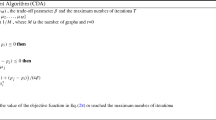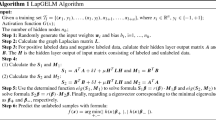Abstract
The structural information of data contains useful prior knowledge and thus is important for designing classifiers. Extreme learning machine (ELM) has been a potential technique in handling classification problems. However, it only simply considers the prior class-based structural information and ignores the prior knowledge from statistics and geometry of data. In this paper, to capture more structural information of the data, we first propose a Fisher-regularized extreme learning machine (called Fisher-ELM) by applying Fisher regularization into the ELM learning framework, the main goals of which is to build an optimal hyperplane such that the output weight and within-class scatter are minimized simultaneously. The proposed Fisher-ELM reflects both the global characteristics and local properties of samples. Intuitively, the Fisher-ELM can approximatively fulfill the Fisher criterion and can obtain good statistical separability. Then, we exploit graph structural formulation to obtain semi-supervised Fisher-ELM version (called Lap-FisherELM) by introducing manifold regularization that characterizes the geometric information of the marginal distribution embedded in unlabeled samples. An efficient successive overrelaxation algorithm is used to solve the proposed Fisher-ELM and Lap-FisherELM, which converges linearly to a solution, and can process very large datasets that need not reside in memory. The proposed Fisher-ELM and Lap-FisherELM do not need to deal with the extra matrix and burden the computations related to the variable switching, which makes them more suitable for relatively large-scale problems. Experiments on several datasets verify the effectiveness of the proposed methods.




Similar content being viewed by others
References
Huang GB, Chen YQ, Babri HA (2002) Classification ability of single hidden layer feedforward neural networks. IEEE Trans Neural Netw 11(3):799–801
Rumelhart DE (1986) Learning representations by back-propagating errors. Nature 323:533–536
Hagan MT, Menhaj MB (1994) Training feedforward networks with the marquardt algorithm. IEEE Trans Neural Netw 5(6):989–993
Chng ES, Yang HH, Bos S (1996) Orthogonal least-squares learning algorithm with local adaptation process for the radial basis function networks. IEEE Signal Process Lett 3(8):253–255
Huang G, Song S, Wu C (2012) Orthogonal least squares algorithm for training cascade neural networks. IEEE Trans Circuits Syst I Regul Pap 59(11):2629–2637
Cortes C, Vapnik V (1995) Support-vector networks. Mach Learn 20(3):273–297
Vapnik Vladimir N (2002) The nature of statistical learning theory. IEEE Trans Neural Netw 8(6:1564–1564
Huang GB, Zhu QY, Siew CK (2004) Extreme learning machine: a new learning scheme of feedforward neural networks. In: Proceedings 2004 IEEE International Joint Conference on Neural Networks. IEEE
Huang GB, Zhu QY, Siew CK (2006) Extreme learning machine: theory and applications. Neurocomputing 70(1):489–501
Huang GB, Chen L, Siew CK (2006) Universal approximation using incremental constructive feedforward networks with random hidden nodes. IEEE Trans Neural Netw 17(4):879–892
Wang Y, Cao F, Yuan Y (2011) A study on effectiveness of extreme learning machine. Neurocomputing 74(16):2483–2490
Huang GB, Zhou H, Ding X, Zhang R (2012) Extreme learning machine for regression and multiclass classification. IEEE Trans Syst Man Cybern Part B Cybern A Publ IEEE Syst Man Cybern Soc 42(2):513–529
Wang Z, Zhao Y, Wang G (2017) Extreme learning machine for large-scale graph classification based on mapreduce. Neurocomputing 261:106–114
Yang L, Zhang S (2016) A sparse extreme learning machine framework by continuous optimization algorithms and its application in pattern recognition. Eng Appl Artif Intell 53:176–189
Wang GG, Lu M, Dong YQ, Zhao XJ (2016) Self-adaptive extreme learning machine. Neural Comput Appl 27(2):291–303
Zhang Y, Wu J, Cai Z, Zhang P, Chen L (2016) Memetic extreme learning machine. Pattern Recogn 58(C):135–148
Ding XJ, Chang BF (2014) Active set strategy of optimized extreme learning machine. Sci Bull 59(31):4152–4160
Huang GB, Ding XJ, Zhou HM (2010) Optimization method based extreme learning machine for classification. Neurocomputing 74:155–163
Davis JC (1996) Introduction to statistical pattern recognition. Comput Geosci 22(7):833–834
Gupta H, Agrawal AK, Pruthi T, Shekhar C, Chellappa R (2002) An experimental evaluation of linear and kernel-based methods for face recognition. In: IEEE workshop on applications of computer vision. IEEE Computer Society, p 13
Xiong T, Cherkassky V (2005) A combined SVM and LDA approach for classification. IEEE Int Joint Conf Neural Netw 3:1455–1459
Zafeiriou S, Tefas A, Pitas I (2007) Minimum class variance support vector machines. IEEE Trans Image Process A Publ IEEE Signal Process Soc 16(10):1651
An W, Liang M (2013) Fuzzy support vector machine based on within-class scatter for classification problems with outliers or noises. Neurocomputing 110(6):101–110
Zhang L, Zhou WD (2016) Fisher-regularized support vector machine. Inf Sci 343–344:79–93
Iosifidis A, Tefas A, Pitas I (2013) Minimum class variance extreme learning machine for human action recognition. IEEE Trans Circuits Syst Video Technol 23(11):1968–1979
Iosifidis A, Tefas A, Pitas I (2015) Sparse extreme learning machine classifier exploiting intrinsic graphs. Elsevier, Amsterdam
Iosifidis A, Tefas A, Pitas I (2016) Graph embedded extreme learning machine. IEEE Trans Cybern 46(1):311
Belkin M, Niyogi P, Sindhwani V (2006) Manifold regularization: a geometric framework for learning from labeled and unlabeled examples. JMLR.org
Chapelle O, Sindhwani V, Keerthi SS (2008) Optimization techniques for semi-supervised support vector machines. J Mach Learn Res 9(1):203–233
Melacci S, Belkin M (2009) Laplacian support vector machines trained in the primal. J Mach Learn Res 12(5):1149–1184
Huang G, Song S, Gupta JND, Wu C (2014) Semi-supervised and unsupervised extreme learning machines. IEEE Trans Cybern 44(12):2405
Iosifidis A, Tefas A, Pitas I (2014) Regularized extreme learning machine for multi-view semi-supervised action recognition. Neurocomputing 145(18):160–262
Zhou Y, Liu B, Xia S, Liu B (2015) Semi-supervised extreme learning machine with manifold and pairwise constraints regularization. Neurocomputing 149(PA):180–186
Liu B, Xia SX, Meng FR, Zhou Y (2016) Manifold regularized extreme learning machine. Neural Comput Appl 27(2):255–269
Pei H, Chen Y, Wu Y, Zhong P (2017) Laplacian total margin support vector machine based on within-class scatter. Knowl Based Syst 119:152–165
Mangasarian OL, Musicant DR (1999) Successive overrelaxation for support vector machines. IEEE Trans Neural Netw 10(5):1032–7
Acknowledgements
This work was supported in part by National Natural Science Foundation of China (No11471010) and Chinese Universities Scientific Fund.
Author information
Authors and Affiliations
Corresponding author
Additional information
Publisher's Note
Springer Nature remains neutral with regard to jurisdictional claims in published maps and institutional affiliations.
Rights and permissions
About this article
Cite this article
Ma, J., Wen, Y. & Yang, L. Fisher-regularized supervised and semi-supervised extreme learning machine. Knowl Inf Syst 62, 3995–4027 (2020). https://doi.org/10.1007/s10115-020-01484-x
Received:
Accepted:
Published:
Issue Date:
DOI: https://doi.org/10.1007/s10115-020-01484-x




